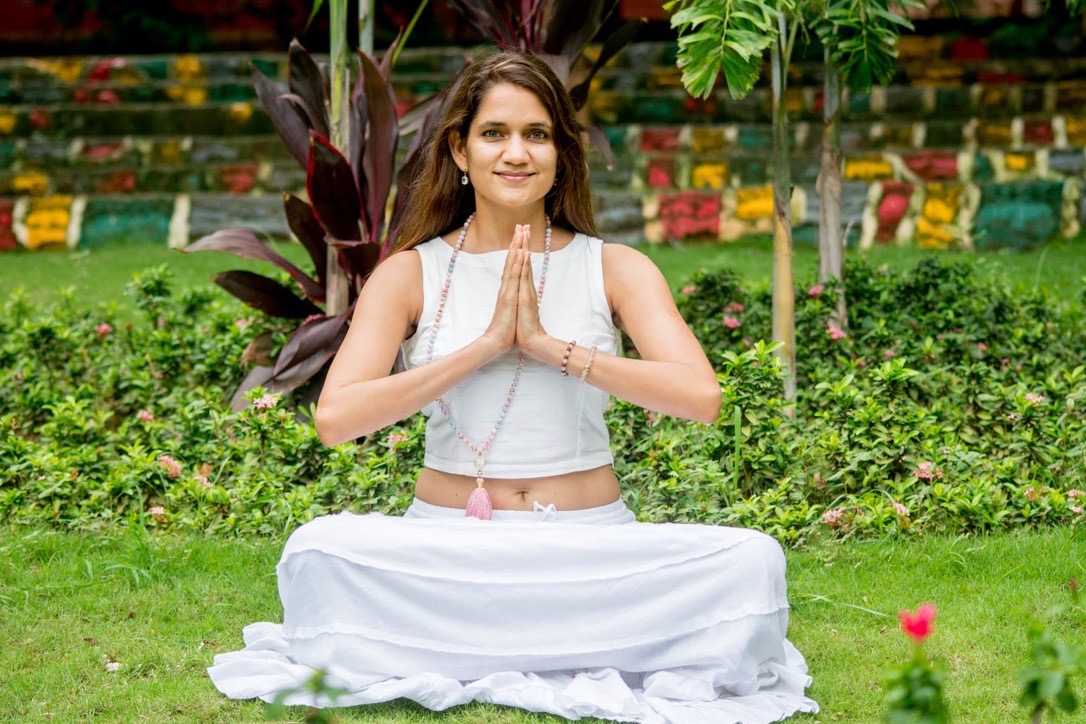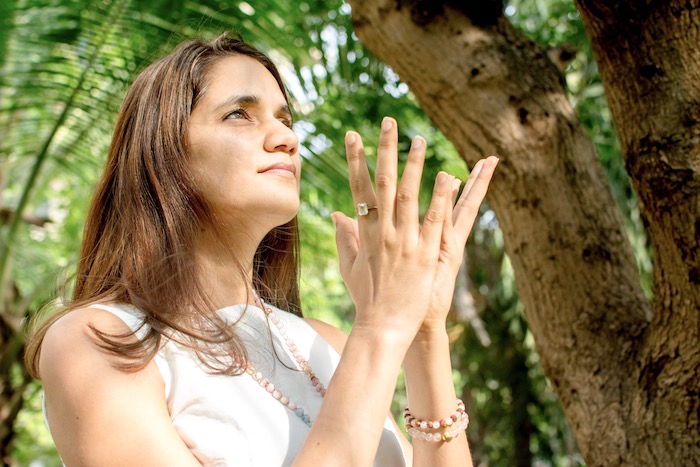An edited and shorter version of this article has been published by Elephant Journal. Click here to read.
Life is the period between one breath and the next; a person who only half breathes, only half lives – Hatha Yoga Pradipika
Breath performs an extremely important role in our life, not only does it have significant health benefits at a physical level but it also connects us with our spiritual nature. Purely by breathing correctly we can relax our nervous system, improve our immunity, clear out physical as well as emotional blockages and replenish our energy. Poor breathing is as much a result of poor posture as it is of poor emotions or poor food habits. Whether it is over eating, wearing ill fitted clothes, stress, emotional turmoil, long sitting hours, lack of movement or a weak core – each exerts its own influence on our breathing pattern, which in turn influences our entire emotional and physical capabilities.
On an average we breathe 15 times a minute, this corresponds to an average human life span of 100 years. It is said that each one of us is born with a fixed number of breaths, implying that the slower we breathe, the longer we live. Or that the slower we use up our energy, the longer it will last. Drawing parallels in nature the Tortoise breathes about 4 times a minute and can live for over 150-200 years, Dogs have a breathing rate of up-to 35 times per minute and just so have a shorter life span. A more recent version to this concept can be found in the Rate of Living Theory by Max Rubner which states that faster the metabolism of an organism, shorter will be its lifespan.
Even Yoga isn’t Yoga unless it is done with breath, only when an aasana is coordinated with breath does it truly become powerful enough to heal. This is what I loved about Mysore Style of teaching during my Yoga Teacher Training course. We would never count the seconds or keep a watch, we were instead taught to count the number of breaths we could hold an aasana for. After ensuring alignment we had to simply focus on making the breath long, deep and effortless. We would go through the entire vinyasa of around 84 aasanas being mindful of the breath in every moment, yet the daily practice would never get tiresome or perhaps that’s the very reason it did not.
While breathing is an evolutionary intuitive force, we have lost touch with it due to our modern lifestyle which is severely disconnected with nature and replete with constant stress stimuli. ‘Belly breathing’ is considered the most relaxing and efficient way of breathing yet we hardly breathe this way anymore. It happens when the abdomen rises up as we inhale and drops as we exhale. All other forms of breathing serve different purposes which our body naturally resorts to as per requirement. For instance, chest/thoracic breathing during physical or emotional stress or clavicular/collar bone breathing when we are sobbing. But most of our day today activities are best serviced by correct belly breathing hence we must remember to get back to it during the day. Even taking a few minutes out daily to center ourselves and reconnect with the breath will retrain our body to breathe correctly even when we are too busy to notice.
Impact of breath on the physical body
Shallow Breathing equals stress. When a breath is taken to full capacity the lungs expand making the diaphragm move down which massages the abdominal organs and helps in improving the digestive processes. Just as incorrect breathing tenses up the body and its systems, conversely stress also increases the breathing rate. When we inhale we take in oxygen which energizes us, as we exhale we release carbon dioxide which relaxes us. Thus long deep breaths are synonymous with vitality and shallow passive breaths make us fatigued and easily tired in smallest of tasks. When we breathe quickly we’re inhaling and exhaling less than optimum quantity of air, we are also not using the lungs to full capacity or giving body enough time to assimilate oxygen. This can cause stale or stagnant air to accumulate in the extreme regions of our lungs and also slow down our metabolism. Therefore, it is equally essential to have a healthy breathing rate such that enough time is available to assimilate the oxygen from lungs into the bloodstream.
Impact of breath on the subtle body
In yoga we are taught to observe the passage of breath and it’s accompanying sensations through our nostrils. Specifically, in Swara Yoga, actions of the day are defined by virtue of the breath being stronger in which nostril. Throughout the day one nostril will almost always have predominance over the other, usually the switch from one to the other happens every 90 minutes. All yogic practices are aimed at equalizing this flow of breath so it flows through the central channel.
Nasal passage purifies and adjusts air. Breathing through the mouth is both unaesthetic and unscientific. You should always breathe through your nasal passage – except in emergencies. If you are just born and they hold you upside down, or you are running a marathon and your pulse rate goes beyond a certain level, or it is your last breath and you want to live for one more minute – then it is all right. Otherwise, always breathe through your nostrils because the nasal passage is there for this purpose – make use of it. – Sadhguru Jaggi Vasudev
When the breath is flowing equally through both the nostrils, every system in the body is considered to work at optimum capacity. More importantly the passage of the nostrils contains a large number of nerve fibers which are linked to the involuntary activities of our body like respiration, digestion, heart beat etc. If we do not breathe from the nose, we do not activate these nerve fibers and this does not send the right signals to our organs. This makes it a very critical area for the nervous system with direct impact on the functioning of our principal organs. Another benefit of breathing through the nose is better assimilation of oxygen due to the presence of Nitric Oxide exclusively in our sinuses. Nitric oxide helps in more efficient absorption of oxygen which cannot be achieved in breathing through the mouth since it is only present in our sinuses. Thus while at a physical level the nostrils help neutralize the temperature, filter out particles and also moisturize the breath they also exert great influence on our entire body-mind complex.
In fact, the very act of being mindful of the breath is transformational. It is no surprise that most meditation techniques begin the practice with focus on breath. Be it Buddhism or Vipassana where you simply start by bringing your attention to the movement of the breath or Yoga where Pranayama is a precursor to Samadhi in the Ashtanga philosophy of Patanjali. It is said that during pranayama, at a physiological level, the longer we retain our breath (Kumbhaka in yoga speak) the more nerve impulses are generated. As the retention is sustained for longer and longer this nervous energy keeps building up, till eventually it causes new pathways to be created in our brain for these impulses to traverse. This results in activation of the latent centers of our brain which otherwise lie unutilized. Not only does this improve our overall efficiency it helps us develop greater control over our mind and even the involuntary organ systems of our body. That’s why yogis are known to have mastery over their coronary, endocrine or digestive systems.
However as has been the warning in all Yogic literature, one shouldn’t ignore the repercussions of reckless pranayama practices including over straining our systems and nadi channels, especially through unsupervised breath retention. Traditionally breath retention is strictly forbidden for children and the full scope only recommended post the age of 50.
Relationship between Breath and Prana
Prana is the subtle energy or vital force created by the physical act of breathing. Everything in the universe is considered a manifestation of Prana. Whether living or inanimate, a bird or a rock, they only vary in the quantum of prana contained in them. Everyone is born with a certain amount of Prana which to a large extent governs their innate capabilities and personality traits. The same can be influenced by positive thinking, yoga practices and by maintaining a healthy emotional state. Prana depletes at an accelerated pace if we succumb to lower emotions of fear, anger, lust etc. Physically it is generated through right food, water, exposure to sun and through air. The last method also holds great significance for Pranic Healers who often tap Pranic energy for healing through the atmospheric ions with specific breathing techniques.
प्राण एव पर॑ मित्र॑ प्राण एव पर॑ सखा ।
Prana evam param mitram prana evam param sakha
Prana is the greatest friend, Prana is the greatest companion ~ Shiva Sarvodaya
Pranayama itself is composed of two words Prana and Ayama (control), roughly translating as control of Prana. It is not limited to breath as we often assume; it is a way to control energy and make it powerful through intense concentration. This power is achieved by maintaining specific patterns of inhalation, exhalation and retention. Each pranayama serves a different purpose and creates specific vibrations in our body that impact us at the cellular level. The rhythm of the breath in initial stages is kept simply by keeping a mental count. For instance, in initial stages of Nadi Shuddhi Pranayama we may begin with 4 count inhalation, 8 count retention and 8 count exhalation. While keeping count is one of the elementary ways to do it, using mantras is also a very effective method to regulate breath and maximize creation of Prana. It is said that the Gayatri Mantra creates the most ideal breathing pattern when chanted correctly. Aum and Soham are two other universal mantras that can be combined with pranayama practice.
From rhythmical breathing comes a tendency of all the molecules in the body to move in the same direction. When mind changes into will, the nerve currents change into a motion similar to electricity, because the nerves have been proved to show polarity under the action of electric currents – Swami Vivekananda
Pranayama is an extremely powerful phenomenon that should never to be practiced without a teacher. Watching a show on TV and doing bizarre versions of ‘anuloma viloma’, literally snorting air loudly through nostrils would perhaps be nothing short of ghastly if we had the clairvoyance to see what was happening to our Pranic bodies. Once you start working with the breath in your practice there are far reaching changes not necessarily limited to the physical. There can be energy upheavals, emotional reactions, old aches and pains can come back – it’s akin to what is often called a ‘healing crisis’ when you start a detox. But with guidance you can get through this practice safely and also learn to channel the energy correctly. Which in any case is the ultimate goal of Hatha Yoga, to lead us to the doors of Raja Yoga so we can begin the journey of moving on from the external, individual, physical aspect to higher awareness. To understanding that we are all but a part of the universal energy, the cosmic Prana and are cut from the same fabric.
For Pranayama is not merely the science of breath, but the science of universal energy, universal mind, time, space and matter. It is a system through which the vital, Pranic energy that holds the universe together is dynamized and redistributed at various levels of existence. – Swami Niranjanananda Saraswati








What an absolutely lucid and informative read!
Thank you for dropping by PG. So happy to know you enjoyed it 🙂